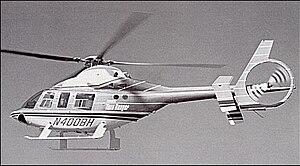Bell 400 TwinRanger
| Bell 400 TwinRanger Bell 440 | |
|---|---|
 A Bell 400 prototype | |
| General information | |
| Type | Multipurpose utility helicopter |
| National origin | United States |
| Manufacturer | Bell Helicopter |
| Status | Canceled |
| Number built | 7[citation needed] |
| History | |
| First flight | 4 April 1984 |
| Developed from | Bell 206L LongRanger |
The Bell 400 TwinRanger was a prototype four-bladed, twin-engine civil helicopter developed by Bell Helicopter in the 1980s. Both the TwinRanger and another planned version, the Bell 440, were attempts to market a twin-engine development of the Model 206L LongRanger. The Bell 400A was a planned single-engine version of the 400. TwinRanger, however development was canceled when Bell could not acquire enough orders for production. The TwinRanger name was later used for a twin-engine version of the LongRanger produced from 1994 to 1997.
Development
[edit]Bell has tried several incarnations of a twin-engine version of its successful Bell 206 series. The TwinRanger name dates back to the mid-1980s when Bell first considered developing a twin-engine version of the LongRanger.
The Bell 400 TwinRanger featured a reprofiled fuselage, two Allison 250 turboshafts, the OH-58D Kiowa's four-bladed main rotor, and a new shrouded tail rotor.[1] Bell also planned the single-engine 400A, and the 440 twin with a larger fuselage made possible by a high degree of composites.[2] The Bell 400 first flew on April 4, 1984. Bell suspended development of the 400/440 family in the late 1980s as it felt unable to achieve a profitable production rate of 120 units a year.[1]
Successors
[edit]After the success of Tridair's Gemini ST twin-engine conversions of the 206L in the early 1990s, Bell produced the equivalent Bell 206LT TwinRanger based on the 206L-4. Only 13 206LTs were built between 1994 and 1997. The 206LT was replaced in Bell's lineup by the Bell 427, a mostly-new development of the Bell 407, itself a four-bladed single-engine derivative of the 206L.[1]
Variants
[edit]- Bell 400
- Bell 400A
- Projected model to be powered by one PW209T turboshaft of 937 shp (699 kW).[2]
- Bell 440
Specifications (Bell 400)
[edit]Data from The Illustrated Encyclopedia of Helicopters[2]
General characteristics
- Crew: 1
- Capacity: 5 passengers
- Empty weight: 3,075 lb (1,395 kg)
- Max takeoff weight: 5,500 lb (2,495 kg)
- Powerplant: 2 × Allison 250-C20P turboshaft, 420 shp (310 kW) each
- Main rotor diameter: 35 ft 0 in (10.67 m)
- Main rotor area: 962 sq ft (89.4 m2)
Performance
- Maximum speed: 172 mph (277 km/h, 149 kn)
- Cruise speed: 161 mph (259 km/h, 140 kn)
- Range: 450 mi (730 km, 390 nmi)
- Service ceiling: 10,000 ft (3,000 m)
- Rate of climb: 2,000 ft/min (10 m/s)
See also
[edit]Related development
References
[edit]- ^ a b c Frawley, Gerard: The International Directiory of Civil Aircraft, 2003-2004, page 43. Aerospace Publications Pty Ltd, 2003. ISBN 1-875671-58-7
- ^ a b c Apostolo, Giorgio; Elfan ap Rees (1984). The Illustrated Encyclopedia of Helicopters. New York, NY, USA: Bonanza Books. pp. 50. ISBN 0-517-43935-2.
